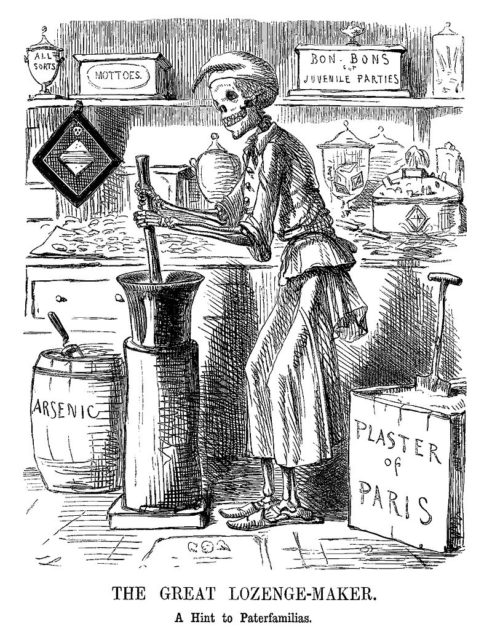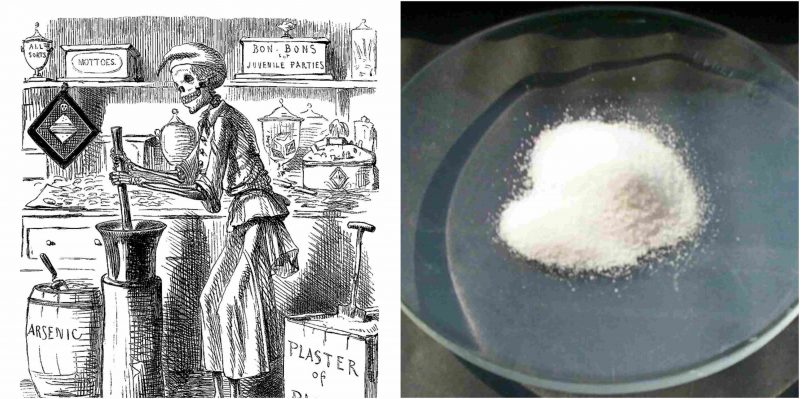In a mistake that caused widespread grief and outrage, at least 20 people died and nearly 200 became seriously ill from peppermint candy that had arsenic mixed in with the usual ingredients.
On Sunday morning, October 30, 1858, the deaths of two young boys, nine and eleven years of age, were reported to Borough Street Station. Initially, cholera was blamed, as there was no evidence of foul play. As the day went on, more deaths were reported and with sudden and violent illness in many households in the district, it seemed as if a plague had hit. Immediately, police officers started the investigation that eventually would discover that the innocent-looking peppermints had contained arsenic.
The peppermint humbugs were sold by William Hardaker, also known locally as “Humbug Billy”, who operated a stall in Greenmarket in Bradford, England.

Police officers followed their leads back to Hardaker and found him ill at home after having eaten his own candy. He told them that the candy had come from Joseph Neal from whom he always purchased his stock. Neal was a candy maker and wholesale confectionery dealer whose workshop was just a few hundred yards to the north of Greenmarket on Stone Street. In 1858, sugar was quite expensive, and Neal had a habit of swapping out some of the sugar for something called “daft”. The substitute, in this case, was supposed to be a powdered gypsum that cost only ½ d per pound, compared to sugar, which was 6 ½ d per pound.
At Neal’s house, the officer discovered that the candy was made by adding daft to reduce the amount of sugar needed. He said the daft was Derbyshire spar, and that 12 pounds of this substance was mixed with 400 pounds of sugar to bring down the expense of making the candy. The trail led to Mr. Hodgson, the druggist who supplied the daft, and it was here officials found that the fatal mistake had been made by an assistant, who drew what he thought was twelve pounds of daft from an unmarked barrel. Mr. Hodgson was horrified and quickly told the officer the contents of the barrel was not daft, but arsenic.
Neal didn’t make the candy himself, instead he employed an experienced candy maker named James Appleton.
Appleton used the powdered arsenic in the production of the peppermint humbugs and failed to notice that the candy looked different from how it normally came out. After making the sweets, Appleton fell ill for many days. No one connected his illness at the time to the candy he was making, so the mistake in the ingredients continued to go unnoticed. Hardaker thought the sweets looked different from what he normally bought and, as a shrewd businessman, he negotiated a lower price and purchased forty pounds of the candy from Neal.
That Saturday night, Hardaker sold 5 pounds of the candy to unsuspecting customers. The peppermints were one ounce apiece and came in packages of 10 to 12, which is why so many people in a single family fell ill from them. The district bellman woke most people up on Sunday around midnight with his warning cries about the dangerous candy and by Monday morning, the entire district knew the candy was poisoned.
On the following Monday, William Goddard, the druggist assistant who sold the arsenic, was in court facing judges.

Dr. John Bell and Felix Rimmington (a chemist and analytical chemist) identified and confirmed that the humbugs contained arsenic. It was estimated that each piece of candy contained 14-15 grains of the deadly substance – 4.5 grains was recognized as a lethal dose.
Enough peppermint candies were sold by Hardaker to kill at least 2,000 people. By the end of the court trial, Charles Hodgson, Joseph Neal, and William Goddard were all charged with manslaughter through negligence. However, both Neal and Goddard were discharged without a blemish and Hodgson later acquitted, so the case of the poisoned peppermint humbugs became well known as a series of tragic errors.
